Uncategorized
By COO & Sisterhood, Not Cisterhood Coordinator Heather Knoxville 
This month, Trans Empowerment Project (TEP) is holding space to talk about Suicide and Self-Harm Prevention, specifically about the alarmingly high suicide rates in the Trans community and what can be done to reduce them. I’m Heather Knoxville, COO of TEP and the creator/manager of our Sisterhood, Not Cisterhood program.
As cis women, it’s essential to recognize our role in providing support and allyship for our Trans sisters. True allies go beyond token gestures and demand consistent effort to create a safe and inclusive environment for everyone.
As an ally myself, it’s important to me that we make it very clear that we are a sisterhood, and we will not allow for continued harm of our Trans sisters, or any of our siblings in the Trans community. Keep reading to discover a roadmap of actionable measures that we can undertake to help the Trans community during Suicide Prevention Month and beyond.
Suicide and Self-Harm in the Trans Community
Personally, one of the things that upset me the most is hearing how alone and isolated my sisters feel. I know that feeling all too well – I spent 15 years with my abuser, who kept me as isolated as possible. (Because we’re easier to control that way, you know.)
Studies have shown that around 77% of Trans women have attempted suicide or had suicidal thoughts at some point in their lives. The situations that lead to these mental health struggles include discrimination, lack of acceptance, violence, and sexual assault/harassment. As cis women, acknowledging and addressing these issues in our spheres of influence can make a significant difference in helping our Trans sisters.
How You Can Help
Here are some practical steps that cis women can take to show support for Trans women:
- Use correct pronouns and names: Be mindful of using the correct pronouns and names chosen by your Trans siblings. This simple act validates and shows respect for their identity.
- Challenge Transphobia: Speak out against Transphobic comments and behaviors in daily life, social settings, and online spaces. You don’t have to say the “perfect” thing, just say something!
- Advocate for Trans-inclusive policies: Promote and support policies in the workplace and community that accommodate the needs, rights, and well-being of Trans folks.
- Amplify Trans voices: Raise awareness about the experiences and perspectives of the Trans community through social media, activism, and engaging in conversations with others.
- Don’t use language that isn’t inclusive! (e.g., saying that women should be able to “create life” or that men can’t.)
- Use the buddy system: If you have Trans friends or loved ones, do things together! Not only will that give you both the joy of strengthening your relationship, but it can also lessen the odds that our Trans sisters will end up victims of harassment or violence.
It’s Called “Sisterhood”, Not “Cisterhood”
Womanhood has nothing to do with physical characteristics or the clothes someone wears, it’s just who we are. No one should get to gatekeep your access to it, and we shouldn’t get to gatekeep others.
The Sisterhood, Not Cisterhood program aims to bridge the gap between cis women and Trans women by fostering education and community, building a network of femme-led support across the country. Participating in and promoting programs like this empowers Trans women and helps create a safe space for them.
Sisterhood, Not Cisterhood offers workshops, monthly virtual meet-ups, and friendship-building opportunities, ultimately helping to reduce instances of suicide and self-harm in the Trans community, especially among Trans women.
Ally Is a Verb
Allyship is not a pin or sticker you wear to indicate that you’re a “safe” person to be around, being an ally is a lifelong journey that involves continual education and personal growth. It’s important to acknowledge mistakes and learn from them, to be open to change, and to actively seek resources to better understand the Trans community.
Listen, I know it can be hard to hear that you’ve made a mistake or said the wrong thing, especially when you had good intentions. But how will we ever learn how to be better allies if we can’t handle being corrected?
Instead, thank the person for their labor, be grateful they felt safe enough around you to correct your mistakes, tuck that new bit of knowledge away where you can find it next time, and move on.
Maintain a growth mindset and consistently strive to create a better world for everyone, because we all deserve to thrive!
You Can Make a Difference
Collective efforts and intentional practices are vital in addressing the mental health crisis in the Trans community. As cis women and allies, it’s our responsibility to show solidarity with our Trans sisters and foster an environment of inclusivity. This Suicide Prevention Month, let’s commit to unlocking effective allyship and making a tangible difference in the lives of Trans folks.
Every conscious effort we make, no matter how small you think it is, creates an impact in our quest for a world where everyone thrives as their authentic self.
Need help knowing where to start? Check out the main Sisterhood, Not Cisterhood page, or come find me at TEP. ([email protected])
Cheers!
Take Back the Narrative, Uncategorized
A narrative on identity and art by artist, filmmaker, and professor K Pontuti
I grew up in a small farm town in Ohio at a time where there wasn’t any language around queerness or transness—at least nothing positive. It was also a time without the internet so information wasn’t as easily available. I remember hearing phrases like “he’s really sensitive,” ”…so creative,” “…so sweet,” “…really insecure,” which later gave way to “he’s a momma’s boy,” “needs toughening up,” “has to learn what is to be a man,” “must be a queer.”
I was quite sensitive, and I could feel my difference although I didn’t quite understand it. I was also creative and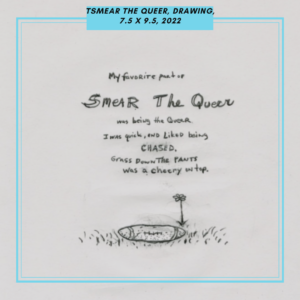 became immersed in my imagination through making things. I taught myself to draw by copying my favorite comics – Charlie Brown and Snoopy were top billed in my cast of characters – and some of my fondest childhood memories are of sewing and crafting with my mom. Soon, though, I was steered towards building model cars and airplanes…“boy stuff.” (My sisters’) Barbies were replaced with G.I. Joes.
became immersed in my imagination through making things. I taught myself to draw by copying my favorite comics – Charlie Brown and Snoopy were top billed in my cast of characters – and some of my fondest childhood memories are of sewing and crafting with my mom. Soon, though, I was steered towards building model cars and airplanes…“boy stuff.” (My sisters’) Barbies were replaced with G.I. Joes.
Like I think many do, I managed by burying it all, and through determination, desperation, and the privileges of a “straight cisgendered man,” I was able to carve out a “good life” for myself as an adult. At least for a while.
Over the years and in hindsight, I remember sensing glimpses of my yet-to-be-recognized queerness through tinglings and fuzzy feelings but mostly just moments of seeing other people living and experiencing life outside of the cisgendered binary and thinking, “Huh…” and sometimes, “That’s beautiful.”
But life’s responsibilities and gendered pathways and norms didn’t leave a lot of room for me to pose these bigger questions to myself. Even though there was an unrecognizable emptiness, anxiety, depression, and
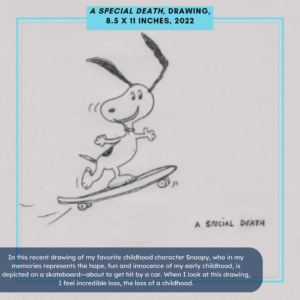 dysphoria manifesting as eating disorders, self-medication, over exercising, and an insatiable drive to prove that I was worth something, I must have known subconsciously that someday this this slimy, hairy, shitball-of-a-person inside of me would be exposed—and I’d have to come to terms with it all.
dysphoria manifesting as eating disorders, self-medication, over exercising, and an insatiable drive to prove that I was worth something, I must have known subconsciously that someday this this slimy, hairy, shitball-of-a-person inside of me would be exposed—and I’d have to come to terms with it all.
A few years ago, as I was wrapping up post production on our film, The Yellow Wallpaper (not ever imagining that I may have been the tragic story’s trapped woman), I fell into a mental health crisis that landed me in the emergency room. I was fortunate to have checked myself in, and even more fortunate to have a supportive partner and family to get me there and back. I started therapy and a long process of excavating the why’s, how’s, and now what’s of why I had forever felt this way (and, of course, this was all happening through the start of the pandemic).
I also started drawing again which was the other thing that saved me. Immersed in the simple act of putting pencil to paper, the ideas started flowing, the dexterity came back, and then it just exploded and everything poured out.
Since then, I’ve been going all in exploring my identity, trauma, and past. Making new drawings and scouring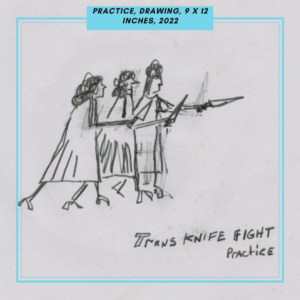 through old ones. Doing more therapy…and lots of shopping.
through old ones. Doing more therapy…and lots of shopping.
As might be expected, my artwork explores themes of gender identity, bodily autonomy, mental health, queerness, and trans rights, all from a very personal perspective. The work is very autobiographical and chronicles my transition as it unfolds, in real time.
This past September, I had my first gallery show in ages and titled it Pray And Be Thankful 4 Everything. For me it was a title that walked a line between irony and authenticity. I was so very thankful for everything, but I was also sick and tired of being told that I should be. The exhibition was amazing on so many levels; personally, professionally, and in an incredibly affirming way. I did as many presentations as I could, especially once I saw the impact it was making.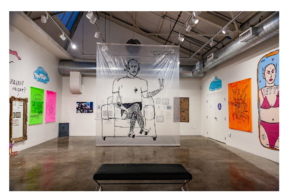
The show provided a platform to start direct conversations about important topics, but definitely raised a lot of eyebrows at the university. Through it all, I’ve received many notes, read student and faculty-written reflections, and had conversations that have brought me to tears. I’ve also felt the ostracization and distancing that many queer and trans people experience. But the good absolutely outweighs the bad, and the joy and satisfaction of realizing who I am, and why I am, has made it one of the most amazing years I could ever imagine.
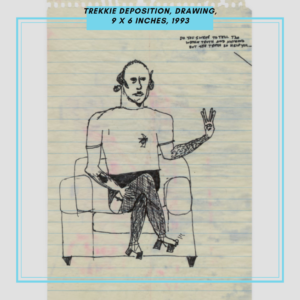
When I look back at my younger self, that sweet kid that liked to sew with mom, who had no idea what was coming their way, no language or support for what was happening to them…I get really sad and feel an incredible loss. The loss of a childhood. And to think it was all spun so well that I thought something was terribly wrong with me.
Now, that sadness turns to anger as I watch people, corporations, even my home state of Ohio, wage war on trans rights (as well as the rights of many others). That sadness turns to rage as I watch the stripping away of the tools, education, and medical care that kids and their families need in order to comprehend who they are and survive.
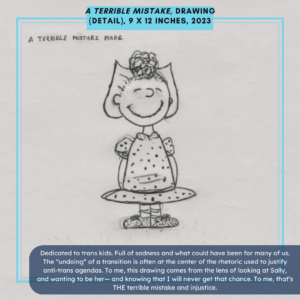
I’m sure it’s not easy to be a trans kid today, but I never had the chance to find out for myself, and the alternative wasn’t so easy for me, either. I’m still doing my daily drawing practice, and I funnel all of my sadness and anger and rage and grief into my art where I can turn it into strength, hope, and self-affirmation. Deep down, I know
these are the things that I need, and I’m now receiving, so that I can continue my journey, and hopefully help others continue theirs.
So yeah, in that sense I am truly thankful.
See more of K’s work on their website: https://www.kpontuti.com/


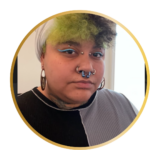
 became immersed in my imagination through making things. I taught myself to draw by copying my favorite comics – Charlie Brown and Snoopy were top billed in my cast of characters – and some of my fondest childhood memories are of sewing and crafting with my mom. Soon, though, I was steered towards building model cars and airplanes…“boy stuff.” (My sisters’) Barbies were replaced with G.I. Joes.
became immersed in my imagination through making things. I taught myself to draw by copying my favorite comics – Charlie Brown and Snoopy were top billed in my cast of characters – and some of my fondest childhood memories are of sewing and crafting with my mom. Soon, though, I was steered towards building model cars and airplanes…“boy stuff.” (My sisters’) Barbies were replaced with G.I. Joes. dysphoria manifesting as eating disorders, self-medication, over exercising, and an insatiable drive to prove that I was worth something, I must have known subconsciously that someday this this slimy, hairy, shitball-of-a-person inside of me would be exposed—and I’d have to come to terms with it all.
dysphoria manifesting as eating disorders, self-medication, over exercising, and an insatiable drive to prove that I was worth something, I must have known subconsciously that someday this this slimy, hairy, shitball-of-a-person inside of me would be exposed—and I’d have to come to terms with it all. through old ones. Doing more therapy…and lots of shopp
through old ones. Doing more therapy…and lots of shopp


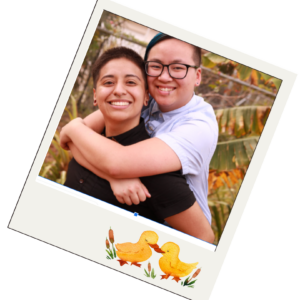 In the burgeoning digital age, it is not uncommon for couples to meet online, and this is
In the burgeoning digital age, it is not uncommon for couples to meet online, and this is 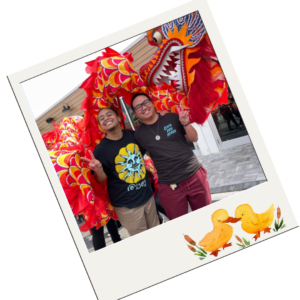
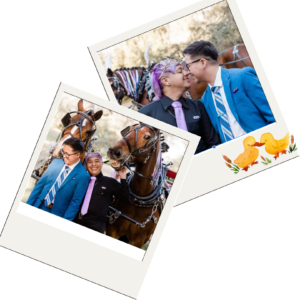 El and Elliott got married on February 20, 2022, and it was absolutely magnificent and
El and Elliott got married on February 20, 2022, and it was absolutely magnificent and